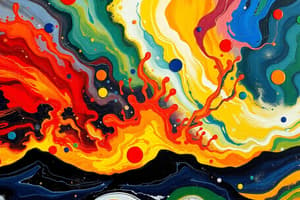Podcast
Questions and Answers
What is a common characteristic of all natural disasters?
What is a common characteristic of all natural disasters?
- They are always weather-related
- They are always unpredictable
- They cause damage and destruction (correct)
- They only occur in the United States
Which of the following natural disasters is caused by a lack of rain over a long period of time?
Which of the following natural disasters is caused by a lack of rain over a long period of time?
- Drought (correct)
- Heat wave
- Blizzard
- Flood
What is the most common type of natural disaster in the United States, according to FEMA?
What is the most common type of natural disaster in the United States, according to FEMA?
- Tornadoes
- Floods (correct)
- Hurricanes
- Earthquakes
What is one way to prepare for natural disasters?
What is one way to prepare for natural disasters?
What is the term for a long snowstorm with high winds for three or more hours?
What is the term for a long snowstorm with high winds for three or more hours?
What is the primary cause of a heat wave?
What is the primary cause of a heat wave?
What is a characteristic of a tornado?
What is a characteristic of a tornado?
What is a common cause of wildfires?
What is a common cause of wildfires?
What is a key step in preparing for a natural disaster?
What is a key step in preparing for a natural disaster?
What is a type of natural disaster caused by underwater earthquakes?
What is a type of natural disaster caused by underwater earthquakes?
Flashcards are hidden until you start studying
Study Notes
- Natural disasters are defined as disasters that happen in nature or by natural processes, not all of which are weather-related, such as pandemics like COVID or the flu.
- 10 of the most common natural disasters include blizzards, droughts, earthquakes, floods, heat waves, hurricanes, thunderstorms, tornadoes, tsunamis, and wildfires.
- All natural disasters cause damage and destruction, sometimes resulting in injuries or death, but many can be predicted ahead of time, allowing for preparation and safety measures.
- Meteorologists can often predict the formation of tornadoes and send out warnings to people to take cover.
- Creating safe spaces and knowing where to go during a disaster is one way to prepare.
- Blizzards are long snowstorms with high winds for three or more hours, caused by cold air colliding with warm air.
- Droughts are caused by a lack of rain over a long period of time, and human activities like deforestation can contribute to them.
- Earthquakes happen when the earth's crust suddenly moves violently, causing the ground to shake.
- Floods occur when heavy rains or melting ice and snow overflow rivers and other bodies of water, filling areas of dry land with water.
- According to FEMA, floods are the most common type of natural disaster in the United States, involving nearly 90% of all disasters.
- Heat waves occur when high pressure in the Earth's atmosphere builds up, holding hot air on the surface, decreasing the chance of rain, and potentially leading to drought.
- Hurricanes are giant swirling storms with severe thunderstorms and high winds, also known as typhoons, occurring only during specific times of the year.
- Thunderstorms include lightning, high winds, and heavy rain, but sometimes hail, sleet, or snow instead.
- Tornadoes are destructive columns of air with wind speeds from 100 to 300 miles per hour, appearing as funnels when they rotate.
- Tsunamis are giant water waves that surge onto land, reaching heights of up to 100 feet, caused by underwater earthquakes disrupting the water.
- Wildfires are dangerous and unpredictable, often started by humans and spreading due to dry weather and strong winds.
- Landslides and avalanches can be caused by earthquakes, heavy rain or snow, or other disasters.
- Active volcanoes are also a cause of natural disasters when they erupt, sending ash clouds into the air and lava onto the ground.
- To be ready for a natural disaster, three things you can do are plan, prepare, and practice, developing a plan, gathering supplies, and rehearsing what to do in case of a disaster.
Studying That Suits You
Use AI to generate personalized quizzes and flashcards to suit your learning preferences.




